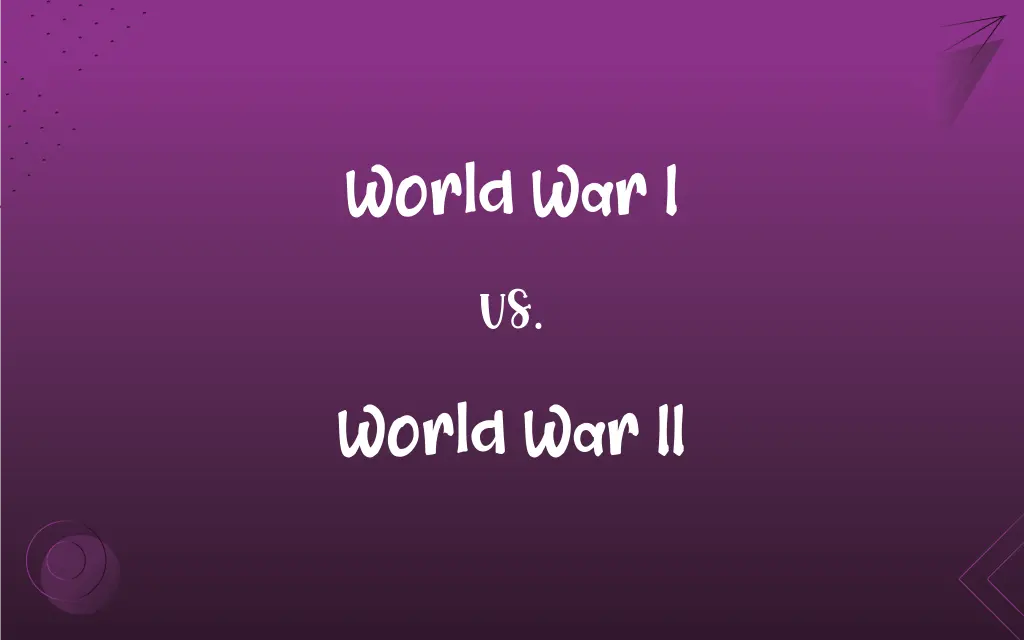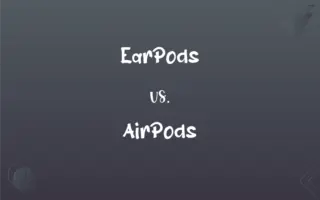World War I vs. World War II: What's the Difference?
Edited by Aimie Carlson || By Harlon Moss || Published on March 19, 2024
World War I (1914-1918) was a global conflict centered on Europe, sparked by nationalism and alliances; World War II (1939-1945) involved broader ideological clashes, including fascism.

Key Differences
World War I was marked by trench warfare and the first use of chemical weapons, leading to unprecedented levels of carnage and destruction on a scale the world had not seen before. World War II, however, was characterized by significant advancements in military technology, including the use of tanks, aircraft, and eventually the atomic bomb, resulting in even greater casualties and widespread devastation.
The causes of World War I centered around complex alliances, militarism, nationalism, and the assassination of Archduke Franz Ferdinand of Austria. In contrast, World War II was largely caused by unresolved issues from World War I, the rise of fascism and totalitarian regimes in Germany, Italy, and Japan, and the policy of appeasement.
World War I saw the collapse of empires, including the Austro-Hungarian, Ottoman, Russian, and German empires. World War II reshaped the global order, leading to the emergence of the United States and the Soviet Union as superpowers and the beginning of the Cold War era.
The Treaty of Versailles, which concluded World War I, imposed heavy reparations and territorial losses on Germany, sowing the seeds of resentment that would contribute to the outbreak of World War II. The end of World War II was marked by the creation of the United Nations, aimed at preventing future global conflicts and fostering international cooperation.
World War I was primarily a European conflict that expanded to other regions, World War II was genuinely global, with major theatres of war in Europe, Africa, Asia, and the Pacific. The global nature of World War II resulted in a far-reaching impact on civilian populations, with mass displacements, genocide, and the Holocaust being defining atrocities of the conflict.
ADVERTISEMENT
Comparison Chart
Dates
1914-1918
1939-1945
Main Causes
Nationalism, alliances, militarism, assassination
Fascism, unresolved WWI issues, expansionism
Key Technologies
Trench warfare, chemical weapons
Atomic bombs, radar, aircraft carriers
Global Impact
Collapse of empires, map redrawn
Cold War, UN formation, superpowers emerged
Economic Consequences
Massive military spending, reparations
Reconstruction, Marshall Plan, economic booms
ADVERTISEMENT
World War I and World War II Definitions
World War I
Marked by significant loss of life and the first instance of total war.
World War I introduced the concept of war affecting civilians and soldiers alike.
World War II
Characterized by significant technological advancements and the Holocaust.
The horrors of World War II included the systematic genocide known as the Holocaust.
World War I
The "Great War," known for trench warfare and the first use of chemical weapons.
The trench warfare of World War I led to devastating stalemates.
World War II
Led to the establishment of the United Nations and the start of the Cold War.
The conclusion of World War II set the stage for the geopolitical tensions of the Cold War.
World War I
A war that resulted in the collapse of several empires.
The aftermath of World War I saw the dissolution of the Ottoman Empire.
World War II
Culminated in the use of atomic bombs on Hiroshima and Nagasaki.
The atomic bombings brought World War II to a dramatic and tragic end.
World War I
A conflict triggered by the assassination of Archduke Franz Ferdinand.
World War I began after a series of alliances were activated.
World War II
Sparked by the aggression of Nazi Germany, Fascist Italy, and Imperial Japan.
World War II's origins can be traced to the expansionist policies of the Axis powers.
World War I
A global conflict from 1914 to 1918, involving most of the world's nations.
World War I changed the geopolitical landscape of Europe dramatically.
World War II
A global conflict from 1939 to 1945, fought between the Axis and Allies.
World War II was the deadliest conflict in human history.
FAQs
What caused World War I?
Complex alliances, nationalism, militarism, and the assassination of Archduke Franz Ferdinand.
What were the main outcomes of World War I?
Redrawing of borders, collapse of empires, and the Treaty of Versailles.
How did World War I impact society?
It led to significant loss of life, social upheaval, and changed gender roles due to women entering the workforce.
How did World War II end?
With the unconditional surrender of the Axis powers following the Allies' victories in Europe and the Pacific.
What role did the United States play in both wars?
It joined World War I in 1917, helping to tip the balance, and was a major force in World War II from 1941 after Pearl Harbor.
How did the Treaty of Versailles contribute to World War II?
Its harsh penalties on Germany created resentment that facilitated the rise of Adolf Hitler.
How did World War II start?
Aggression by Axis powers and failure of appeasement policies.
What was the significance of the Holocaust in World War II?
It was a genocide where six million Jews were systematically murdered by the Nazis.
Who were the Axis and Allies in World War II?
The Axis included Germany, Italy, and Japan; the Allies included the UK, USSR, USA, and others.
What lessons were learned from World War I and World War II?
The importance of international cooperation, the dangers of nationalism and fascism, and the need for effective conflict resolution mechanisms.
How did World War I affect the global economy?
It caused massive economic disruptions, leading to hyperinflation and debt in Europe.
What was the impact of World War II on civilian populations?
Massive casualties, widespread destruction, and the displacement of millions.
What were the main differences in warfare between World War I and World War II?
World War II saw more mobility and technological advancements, unlike the stagnant trench warfare of World War I.
What technological advancements were significant in World War II?
Radar, jet aircraft, and nuclear weapons.
How did the map of Europe change after World War I?
New countries were formed, and borders were redrawn, particularly in Eastern Europe.
What was the significance of the Battle of Stalingrad in World War II?
It was a turning point, with the Soviet Union defeating Germany in a brutal battle.
How did World War I influence art and literature?
It led to disillusionment, reflected in movements like Modernism and works by the "Lost Generation."
How did World War I and World War II reshape international relations?
They led to the creation of the League of Nations and the United Nations, respectively, aimed at preventing future conflicts.
What was trench warfare in World War I?
A form of warfare where opposing armies fought from deep trenches, leading to huge losses for little land gain.
What role did propaganda play in World War II?
It was crucial for boosting morale, recruiting soldiers, and supporting the war effort on the home front.
About Author
Written by
Harlon MossHarlon is a seasoned quality moderator and accomplished content writer for Difference Wiki. An alumnus of the prestigious University of California, he earned his degree in Computer Science. Leveraging his academic background, Harlon brings a meticulous and informed perspective to his work, ensuring content accuracy and excellence.
Edited by
Aimie CarlsonAimie Carlson, holding a master's degree in English literature, is a fervent English language enthusiast. She lends her writing talents to Difference Wiki, a prominent website that specializes in comparisons, offering readers insightful analyses that both captivate and inform.
































































